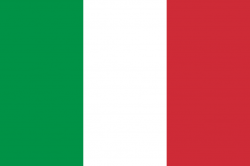 Flag of Italy is one of maximum symbols of the Italian nation, used to represent the republic of the country in international terms.
Flag of Italy is one of maximum symbols of the Italian nation, used to represent the republic of the country in international terms.
Also known among Italians as il Tricolor, a Italy's flag is tricolor, formed by three vertical bands of the same size and with the following colors: green (left), white (center) and red (right). The banner ratio is 2:3.
The current format of the Italy flag began to be used on June 19, 1946, but it was only officially defined on January 1, 1948.
This contemporary flag shape was adopted after World War II, when the Italians went to town. ballot boxes vote in a plebiscite that asked what the preference of the government to be constituted in the country: republic or monarchy.
How disappointed the Italians were with the monarchic model, as it became linked to the fascist regime (called Italian Social Republic - RSI) during the war, 54% of the population opted for the establishment of a democratic republic in the parents.
Meaning of the colors of the flag of Italy
THE French Revolution was a great inspiration in the process of defining the Italian flag.
It was the French Emperor Napoleon Bonaparte who founded the so-called cispadan republic, in 1796, in the north of the Italian Peninsula, being this the first entity to use the tricolor flag (from 1797).
The red and white colors were inspired by the symbol of the Milan commune flag, and the color green was added in reference to the army uniform of the official Milanese guard.
There is no universal consensus on the meaning of the colors of the flag of Italy, however, some historians attribute the following interpretation:
- Green: represents the country's plains and hills;
- White: represents the glaciers of the Alps, in northern Italy;
- Red: represents the blood of heroes that was shed during Italy's wars of independence.
But, mainly from a religious point of view, the colors that characterize the flag of Italy have a different meaning:
- Green: represents hope;
- White: represents faith;
- Red: represents charity;
This interpretation would be related to the three theological virtues, established by the doctrines that govern the morals of the Catholic Church.
See also the meaning of the others country flags and Portugal flag.
